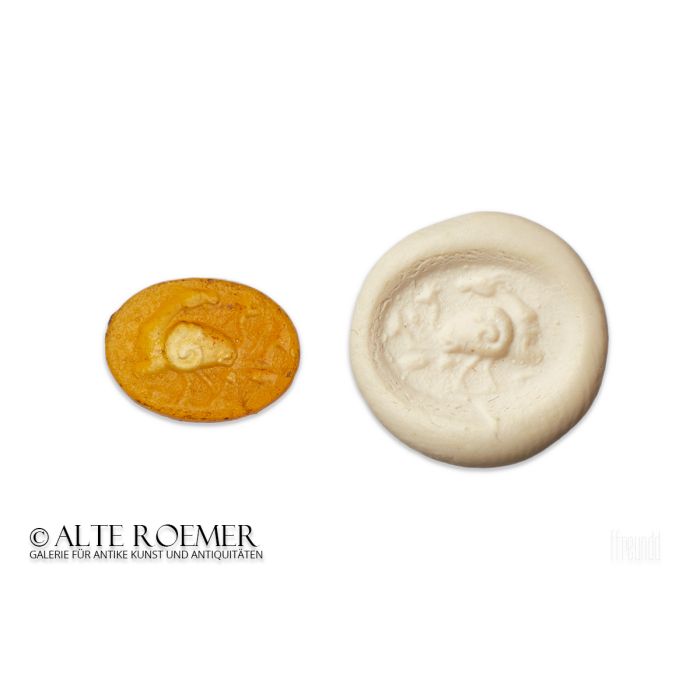Roman intaglio with gryllos
Price: on request
Sold
Object number
AR1950-156
| Object: |
Roman intaglio with Gryllos
|
| Material: |
Orange, transparent glass paste.
|
| Period: |
3rd century BC to mid 2nd century AD. Roman Republic to Roman Imperial times. The italic glass pastes usually pick up motifs from the 3rd to 1st century BC that were popular on stone intaglios of that time. Due to the long use of such motifs the glass paste described here might well date to the Roman Imperial period. |
| Description: |
Quality Roman intaglio made of orange glass paste. The motif is molded in great detail into the clear glass. Oval ring stone with flat image side. The skillful work shows a bird-like grotesque, consisting of a Silenus head in profile with horse protomes on the top of the head. A horned ram's head emerges from the back of the head and is holding something in its mouth. It is a cornucopia and one or more branches. In literature such branches are often identified as an ear of wheat and a palm branch. The creature's legs are those of a rooster. |
| Background: |
The usual name for a hybrid creature of this type is Gryllos. The modern neologism used by archaeologists takes a Greek word and means a deformed, comical figure. Already on Phoenician scarabs from the 6th century BC such images can be found.They became extremely popular during the Roman Empire. They express the belief in the magical power of certain combinations of animals and symbols.
|
| Dimensions: |
13.5mm long, 10mm wide.
|
| Condition: |
Perfect condition. Minimal abrasion to the surface, but the motif remains sharp and detailed.
|
| Provenance: |
From the German collection of Professor H. Brosch (1923 to 2009), author of historical publications, scientific museum advisor, decorated by the Order of Merit of the Federal Republic of Germany. The collection was built between 1960 and 1975. It was inherited to U. Buechner, Germany, and then acquired by us in 2013.
The Professor Brosch collection of ancient Gems: After the decline of the Roman Empire, ancient gems retained or regained recognition in medieval Europe. In addition to frequent reuse in church art, there were also profane uses. This is shown by the example of the ancient intaglio of Julia, daughter of Emperor Titus. It was reused in the 9th century by the Merovingians in the "Escrain de Charlemagne" and can be admired today in the French National Library. The reception of ancient glyptic during the Italian Renaissance resulted in a great fashion to collect gems, which could be entertained by the European educated bourgeoisie during journeys through the Mediterranean in the spirit of enlightenment and education. Thus Goethe, inspired by his trip to Italy, which was immortalised in literature, also built up a collection of antiquities. The collection of ancient intaglios by Professor Brosch is certainly a late classicist continuation of this tradition. The collection forms a systematic cross-section of the thematic diversity of ancient gems and has been worked on extensively with a scholarly approach. Professor Brosch had a great interest, not only in ancient history, but also in the more recent history of his home region. He was honoured with the Federal Cross of Merit for his achievements in the field of historical studies. It is with pride that we have fully documented this collection and provided it with literature references. We are now pleased to bring these miniature works of art from the ancient world back into circulation and to enrich a collection in the tradition of the Renaissance and Enlightenment in a worthy manner. If you are interested in purchasing the collection in its entirety, please do not hesitate to contact us. |
| References: |
Cf. Antike Gemmen in Deutschen Sammlungen, Band I: Staatliche Münzsammlung München, part 2, plate 170, no. 1894. Cf. Staatliche Museen Kassel, acc. no. Ge 85. |
| Literature: |
The classic and main work on the art of ancient engraved seals is A. Furtwaengler, Die antiken Gemmen, Volumes 1 to 3 (Leipzig and Berlin, 1900). A compact introduction and a cross-section of motifs is offered by G. Lippold in Gemmen und Kameen des Altertums und der Neuzeit (Stuttgart, 1921). Our recommendation for budding collectors is H. Gebhart, Gemmen und Kameen (Berlin, 1925). The book is well available in antiquarian bookshops. It provides a very good introduction to the materials used and then goes through the entire history of glyptic with numerous, well-explained examples. |
| Authenticity: |
We unconditionally guarantee the authenticity of every artefact, all items are subject to our lifetime return policy on authenticity.
|


